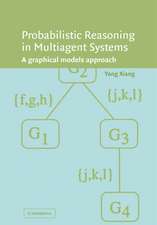Finite Element Methods in CAD: Electrical and Magnetic Fields
Autor Jean Claude Sabonnadiere, Jean Louis Coulomben Limba Engleză Paperback – 20 oct 2013
Preț: 383.12 lei
Nou
Puncte Express: 575
Preț estimativ în valută:
73.31€ • 76.75$ • 60.66£
73.31€ • 76.75$ • 60.66£
Carte tipărită la comandă
Livrare economică 07-21 aprilie
Preluare comenzi: 021 569.72.76
Specificații
ISBN-13: 9781468487411
ISBN-10: 1468487418
Pagini: 208
Ilustrații: VIII, 194 p. 40 illus.
Dimensiuni: 155 x 235 x 11 mm
Greutate: 0.3 kg
Ediția:Softcover reprint of the original 1st ed. 1987
Editura: Springer
Colecția Springer
Locul publicării:New York, NY, United States
ISBN-10: 1468487418
Pagini: 208
Ilustrații: VIII, 194 p. 40 illus.
Dimensiuni: 155 x 235 x 11 mm
Greutate: 0.3 kg
Ediția:Softcover reprint of the original 1st ed. 1987
Editura: Springer
Colecția Springer
Locul publicării:New York, NY, United States
Public țintă
ResearchCuprins
1 Principles of the finite element method.- 1.1. Principle equations of mathematical physics.- 1.2. The idea of a well posed problem.- 1.3. Integral formulation.- 1.4. Approximation of the unknown functions.- 1.5. Minimization of the functional with the aid of approximation functions.- 1.6. The finite element mesh and the approximation functions.- 2 From one dimension ... to three.- 2.1. Elementary principles of the finite element method.- 2.2. Example 1: one dimension.- 2.3. Example 2: two dimensions.- 2.4. Example 3: three dimensions.- 2.5. Example 4: problems in the time domain.- 3 Finite elements and approximation functions.- 3.1. Introduction.- 3.2. One-dimensional elements.- 3.3. Two-dimensional elements.- 3.4. Three-dimensional elements.- 3.5. Conclusion.- 4 Numerical methods.- 4.1. Methods for solving systems of linear equations.- 4.2. Non-linear systems: the Newton-Raphson method.- 4.3. Numerical methods for calculating definite integrals.- 4.4. Differential equations with initial conditions.- 4.5. Conclusion.- 5 General theory of second order isoparametric elements.- 5.1. Introduction.- 5.2. Setting up the equations.- 5.3. Application of the Newton-Raphson method.- 5.4. Construction of the matrix H and the vectors F and R.- 5.5. The finite elements.- 5.6. Application.- 6 General architecture of CAD systems based on the finite element method.- 6.1. General structure.- 6.2. The data entry module.- 6.3. The solver.- 6.4. Postprocessors.- 6.5. Architecture of finite element software.- 6.6. Communication between programs.- 6.7. Interdisciplinary software.- 6.8. Conclusion.- 7 Geometry, mesh generation and physical properties.- 7.1. Description of the geometry.- 7.2. Discretization of the domain.- 7.3. Description of physical characteristics.- 7.4. Conclusion.- 8 Postprocessing.- 8.1. Objectives of postprocessing.- 8.2. Extraction of information.- 8.3. Visualization of the information.- 8.4. Conclusion.- 9 Applications.- 9.1. The FLUX2D package.- 9.2. FLUX3D.- 9.3. Microcomputer software.- 9.4. The super programs.- Conclusion.













